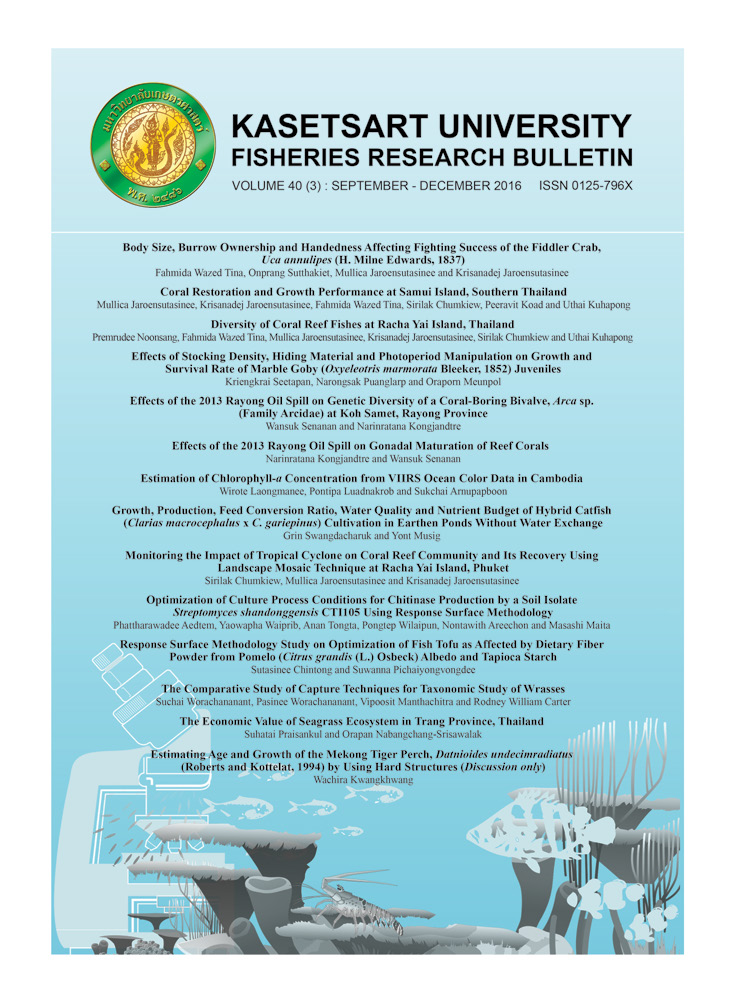Growth, Production, Feed Conversion Ratio, Water Quality and Nutrient Budget of Hybrid Catfish (Clarias macrocephalus x C. gariepinus) Cultivation in Earthen Ponds Without Water Exchange
Main Article Content
Abstract
The potential of closed culture system of hybrid catfish (Clarias macrocephalus x C. gariepinus) without water exchange and without aeration was evaluated whether it can still produce fish in high production rate. The study was done in three earthen ponds in a private fish farm. Growth performance of hybrid catfish was investigated. Pond water quality and pond nitrogen and phosphorus budgets were also studied. Results from this study indicated that closed culture system of hybrid catfish in earthen ponds without water exchange and without aeration with minimum pond management practice both between crops and during grow out period can give high production rate of hybrid catfish. Production of hybrid catfish was 22.3-29.4 t/rai/crop or 139.2-183.7 t//ha/crop. FCR and survival rate of hybrid catfish were 3.7-4.2 and 44.7-59.4% and daily weight gain was 1.7-2.7 g/fish/day. Water quality parameters varied between 30.3-4,552.0 NTU for turbidity, 0.03-7.23 g/l for total suspended solids (TSS), 0.02-1.48 g/l for particulate organic matter (POM), 138.8-827.7 µg/l for chlorophyll a content, 6.7-8.6 for pH, 0.27-132.58 mgN/l for total ammonia nitrogen (TAN), 4.70-295.8 mgN/l for total nitrogen (TN), 0.04-0.74 mgP/l for soluble orthophosphate (SOP), 0.39-10.40 mgP/l for total phosphorus (TP), 0.10-14.60 mg/l for midday surface dissolved oxygen (DO), and 0.10-4.61 mg/l for midday bottom DO. Midday bottom and surface DO concentrations were at low level most time during grow out period indicating the absence of DO during night time. Major input of nitrogen and phosphorus budgets in hybrid catfish ponds were applied feed (98.0+0.6% of nitrogen input and 99.7±0.1% of phosphorus input). Major sinks for nitrogen were harvested hybrid catfish (36.2±6.10%) and pond effluent (35.8±4.14%). Major sinks for phosphorus were pond bottom soil absorption (84.3±2.53%), harvested hybrid catfish (13.6±2.06%), and pond effluent (2.1±0.57%). Hybrid catfish incorporated 36.3±6.4% of nitrogen and 13.4±2.0% of phosphorus inputs from feed.
Article Details
References
2. APHA, AWWA and WEF. 2005. Standard Methods for the Examination of Water and Wastewater, 20th edn. American Public Health Association, American Water Works Association and Water Environment Federation, Washington, DC. USA.
3. APHA, AWWA and WPCF. 1975. Standard Methods for the Examination of Water and Wastewater, 14th edition, APHA, New York. 1193 pp.
4. Department of Fisheries. 2012. Fisheries statistic. Information and Communication Technology center, Department of Fisheries, Bangkok.
5. Areerat, S. 1987. Clarius culture in Thailand.Aquaculture, 63:355-362.
6. Boyd, C.E., K. Corpron, E. Bernard and P. Pengsang. 2006. Estimates of bottom soil and efflluent load of phosphorus at a semi-intensive marine shrimp farm. Journal of the World Aquaculture Society 37:41-47.
7. Briggs, M.R.P. and S.J. Funge-Smith. 1994. A nutrient budget of some intensive marine shrimp ponds in Thailand. Aquaculture Res 25:789-881.
8. Funge-Smith, S.J. and M.R.P.Briggs. 1998. Nutrient budgets in intensive shrimp ponds: implication for sustainability. Aquaculture, 164:117-133.
9. Ingthamjit, S., S. Arreerat, P. Tientong and S. Wallie. 1992. Variation of water quality, phytoplankton and bacteria in catfish pond. Technical paper no. 129. NIFI, Bangkok. 24 pp.
10. Inland Fisheries Advisory Commission. 1973. Water quality criteria for European freshwater fish. Report on ammonia and inland fisheries. Water Res., 7:1.011-1,022.
11. Lin, C.K. and J.S. Diana. 1995. Co-culture of catfish ( Clarius batrachus x C. garieppinus) and tilapia (Oreochromis niloticus) in ponds. Aquat. Living Resour., 8:449-454.
12. Little, D.C., K. Kaewpaitoon and T.Haitook. 1994. The commercial use of chicken processing wastes to raise hybrid catfish (Clarius batrachus x C. garieppinus) in Thailand. NAGA, The ICLARM Quarterly. pp. 25-27.
13. Paez-Ozanu, F., S.R. Guerrero-Galvan, A.C. Ruan-Fernandez and R. Espinosa Angulo. 1997. Fluxs and mass balances of nutrients in a semi intensive shrimp farm in North western Mexico. Marine Pollution Bulletin, 34:290-297
14. Sun, W. and C.E. Boyd. 2013. Phosphorus and nitrogen budgets for inland, saline water shrimpponds in Alabama. Fish Aquac J 4:080. dai:l0.4127/2150-3508.1000080.
15. Teaichert-Coddington, D.R., D. Martinez and E. Ramirez. 2000. Partial nutrient budgets for semi-intensive shrimp fanns in Hondurus. Aquaculture, 190: 139-154.
16. Yi, Y., C.K. Lin and J.S. Diana. 2003. Hybrid catfish (Clarius batrachus x C. garieppinus) and Nile tilapia (Oreochromis niloticus) culture in an integrated pen-cum-pond system: growth performance and nutrient budgets. Aquaculture, 217:395-408.
17. Wahub, M.A., A. Bergheim and B. Braaten. 2003. Water quality and partial mass budget in extensive shrimp ponds in Bangladesh. Aquaculture, 218:413-423.


